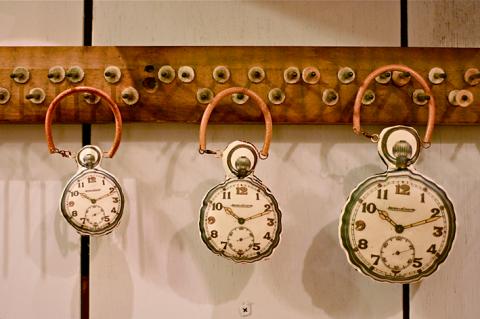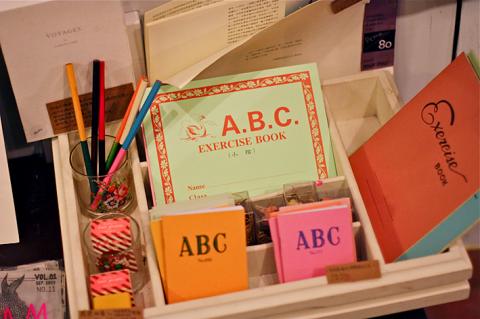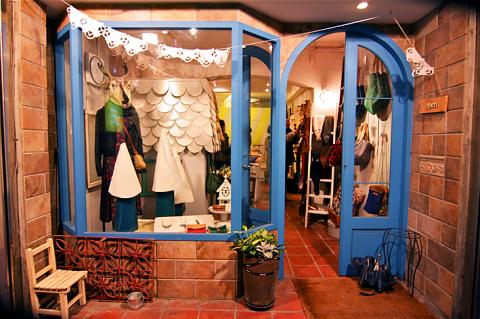Blah Blah Blah is a curiosity shop filled with the weird and wonderful: vintage clothing, handmade accessories and indie zines.
Watches turn out to bracelets with tiny, hand-embroidered clock faces, bags made out of fuzzy fake fur are embellished with portraits of dignified looking cats, and colorful beetles crawl up necklaces.
Blah Blah Blah was founded in 2005 by designer Chen I-shan (陳怡珊) while she was working part time at different boutiques. In her spare time, Chen, whose mother and grandmother taught her how to crochet and sew when she was a girl, stitched bags and clothing for herself. Her friends saw her creations and asked her to make things for them, too.

Photo: Catherine Shu, Taipei Times
Encouraged, Chen began selling her totes at artists’ markets and at stores in Taipei City. She opened her own store near the corner of Zhongxiao East Road and Dunhua South Road three years ago.
Chen says she chose the name Blah Blah Blah because “I’m not very good at using words to express myself.”
“I didn’t go to design school, so I think my style is more free-spirited,” says Chen, who used to sew clothing for her Barbies by hand. “I like combining different materials in new ways and mixing up colors and patterns.”

Photo: Catherine Shu, Taipei Times
Blah Blah Blah’s signature items are reversible totes and handbags sewn from lively printed fabric and made with handles and frames of raw, undyed leather. Some of the cloth used is vintage, like a bright psychedelic print from a Canadian flea market and a modish floral pattern found in an old fabric store Chen stumbled upon while exploring Taitung.
One of Chen’s favorite pastimes is searching for odds and ends to use in her creations. Some pendants are made from vintage shoe buttons, while other necklaces are strung from tiny cube-shaped beads in primary colors imported from Japan.
Another jewelry series features odd-looking pendants made from tree branch slices that are studded with brass nails like the pegs in a pinball machine.

Photo: Catherine Shu, Taipei Times
Blah Blah Blah also carries a colorful assortment of vintage clothing from Japan and Taiwan and a treasure trove of quirky items: ABC practice notebooks from Hong Kong, elaborately beaded bags from the 1950s and 1960s, handmade zines by artist Son (兒子) and colorful rubber toys shaped like letters and numbers that Chen found at the Fuhe Bridge Flea Market (福和橋跳蚤市場).
“I save a lot of little things that I have no idea what to do with at first,” Chen says.
Some of the handicrafts are inspired by children’s toys and books, including Alice in Wonderland. Soft ornaments are sewn from fabric printed with images of clocks and keys and a series of necklaces have pendants made from John Tenniel’s classic illustrations. Sewn from fleece with crocheted heads, “sable” scarves look like cute stuffed animals at first glance, but with leather buttons for eyes and tiny x’s for pupils, the accessories are both whimsical and a little creepy.

Photo: Catherine Shu, Taipei Times
One series of necklaces called Toy Chips was inspired by small plastic pendants called wangzaixian (尪仔仙) that were collected by Taiwanese children in the 1950s and 1960s. Chen cast the original pieces, which she found in a friend’s collection of vintage playthings, in sterling silver and bronze; the shapes include a parrot, a bat and a qilin (麒麟), or Chinese unicorn.
“It’s hard to say exactly where my design inspiration comes from because it’s always different,” Chen says. “I just like to make things that are unexpected.”

This month the government ordered a one-year block of Xiaohongshu (小紅書) or Rednote, a Chinese social media platform with more than 3 million users in Taiwan. The government pointed to widespread fraud activity on the platform, along with cybersecurity failures. Officials said that they had reached out to the company and asked it to change. However, they received no response. The pro-China parties, the Chinese Nationalist Party (KMT) and Taiwan People’s Party (TPP), immediately swung into action, denouncing the ban as an attack on free speech. This “free speech” claim was then echoed by the People’s Republic of China (PRC),

Exceptions to the rule are sometimes revealing. For a brief few years, there was an emerging ideological split between the Democratic Progressive Party (DPP) and Chinese Nationalist Party (KMT) that appeared to be pushing the DPP in a direction that would be considered more liberal, and the KMT more conservative. In the previous column, “The KMT-DPP’s bureaucrat-led developmental state” (Dec. 11, page 12), we examined how Taiwan’s democratic system developed, and how both the two main parties largely accepted a similar consensus on how Taiwan should be run domestically and did not split along the left-right lines more familiar in

As I finally slid into the warm embrace of the hot, clifftop pool, it was a serene moment of reflection. The sound of the river reflected off the cave walls, the white of our camping lights reflected off the dark, shimmering surface of the water, and I reflected on how fortunate I was to be here. After all, the beautiful walk through narrow canyons that had brought us here had been inaccessible for five years — and will be again soon. The day had started at the Huisun Forest Area (惠蓀林場), at the end of Nantou County Route 80, north and east

Specialty sandwiches loaded with the contents of an entire charcuterie board, overflowing with sauces, creams and all manner of creative add-ons, is perhaps one of the biggest global food trends of this year. From London to New York, lines form down the block for mortadella, burrata, pistachio and more stuffed between slices of fresh sourdough, rye or focaccia. To try the trend in Taipei, Munchies Mafia is for sure the spot — could this be the best sandwich in town? Carlos from Spain and Sergio from Mexico opened this spot just seven months ago. The two met working in the